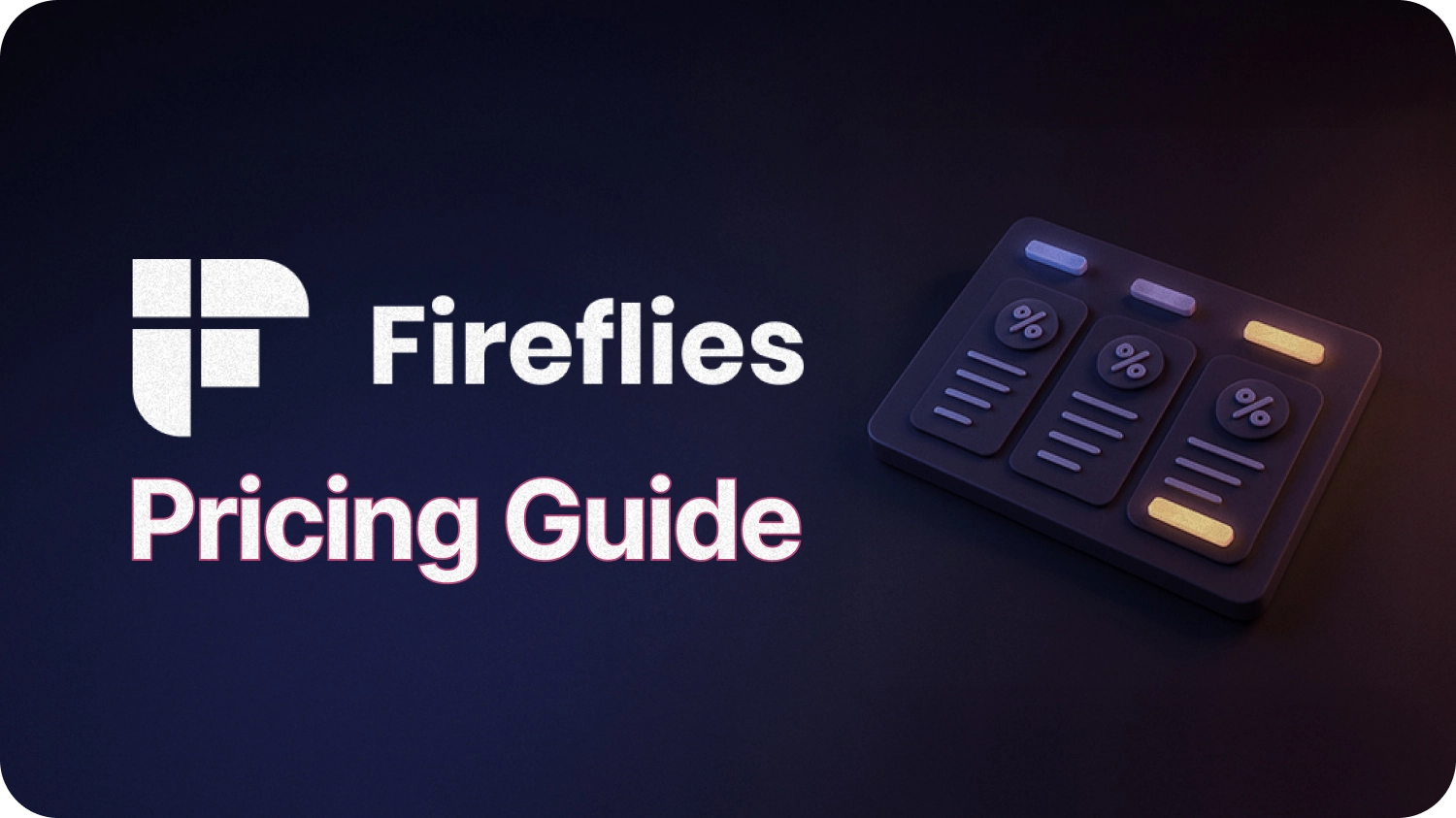Most conversational AI platforms today still feel like glorified chatbots. They handle basic automation and transcription well, but they struggle with nuanced, human conversations.
In 2025, however, a good conversational AI tool is a must-have for any customer-facing team. On top of saving time, it helps you uncover what your customers aren’t saying out loud, flags deal risks, and even shows you how to course-correct in real time.
In this blog, I’ve curated a list of the 10 best conversational AI platforms available in 2025. We’ll review what each one does best, where it falls short, and who it’s best suited for.
What is a Conversational AI Platform?
At a basic level, conversational AI powers chatbots, voice assistants (think Siri or Alexa), and simple Q&A agents. But the real value emerges when the AI does more than just answer scripted questions. In the last few years, conversational AI has evolved from clunky decision trees to contextual understanding, thanks to advancements in generative AI and large language models (LLMs).
Instead of hard-coded rules, modern conversational AI can interpret open-ended queries, remember past interactions, and personalize responses based on context like customer history or sentiment. You might already be using conversational AI daily, for example, virtual assistants like Alexa, Siri, or Google Assistant. They can answer questions, add items to your grocery list, or play a song on command.
But in the business world, conversational AI tools go far beyond that. For example, conversation intelligence platforms can analyze sales calls, monitor customer sentiment, and even coach your reps using insights from real sales conversations. These capabilities make conversational AI a game-changer for revenue teams, not just support chatbots.
10 Best Conversational AI Platforms to Consider
Not all conversational AI platforms are built alike, and picking the wrong one can drain both time and budget. These 10 platforms stand out in 2025 for helping businesses scale conversations, boost efficiency, and unlock real revenue potential.
Here’s a side-by-side look at the top conversational AI platforms of 2025:
1. MeetRecord
MeetRecord stands apart from traditional chatbot platforms. It’s a revenue intelligence and sales coaching platform that acts like an extended member of your sales team. MeetRecord automatically records and transcribes your calls, emails, and meetings, then uses advanced NLP to highlight buyer intent, deal risks, and coachable moments.

It also goes beyond passive analysis with built-in AI roleplay capabilities, allowing reps to practice sales conversations with lifelike bots tailored to real objections, personas, or even specific contacts in the pipeline. These bots can be customized for different deal scenarios, giving reps a realistic environment to sharpen their pitch and objection handling before the actual call.
Unlike traditional chatbot platforms, MeetRecord isn’t built for customer-facing automation but rather it’s designed for internal sales coaching and intelligence. That means your team gets insight and practice tailored to your pipeline, not generic flows.
You can try and experience AI Sales Roleplay first hand here. 👇
Best for:
Sales teams and revenue leaders who want to mine every customer interaction for deal insights and better coaching.
Pros:
Cons:
Pricing:
Custom plans based on your business needs. Book a demo for a tailored quote.
2. IBM Watsonx Assistant
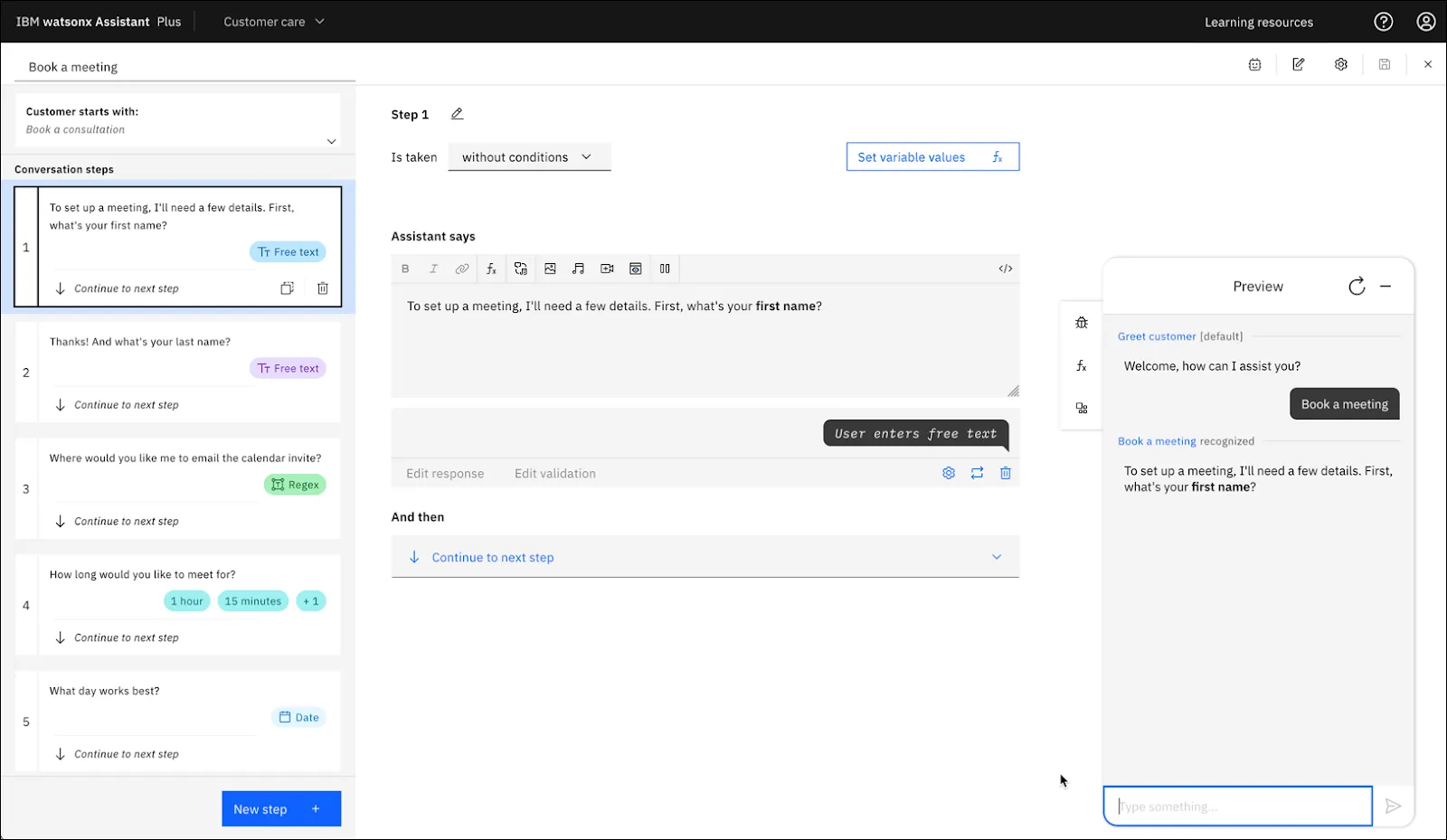
IBM’s Watsonx Assistant is a conversational AI platform for building AI-powered virtual assistants and chatbots.
It provides a no-code, drag-and-drop builder with plenty of pre-built templates, so you can create virtual agents for sales, marketing, or customer service without starting from scratch.
With its powerful language understanding and generative AI capabilities, Watsonx’s bots can deliver context-aware, human-like responses in real time.
Best for:
Businesses that want to build their own AI SDRs (sales development reps) for prospecting, or lead-capture chatbots to engage website visitors.
Pros:
Cons:
Pricing:
A free Lite plan is available to get started. Paid plans then start around $140/month for ~1,000 monthly active users.
3. Amazon Lex
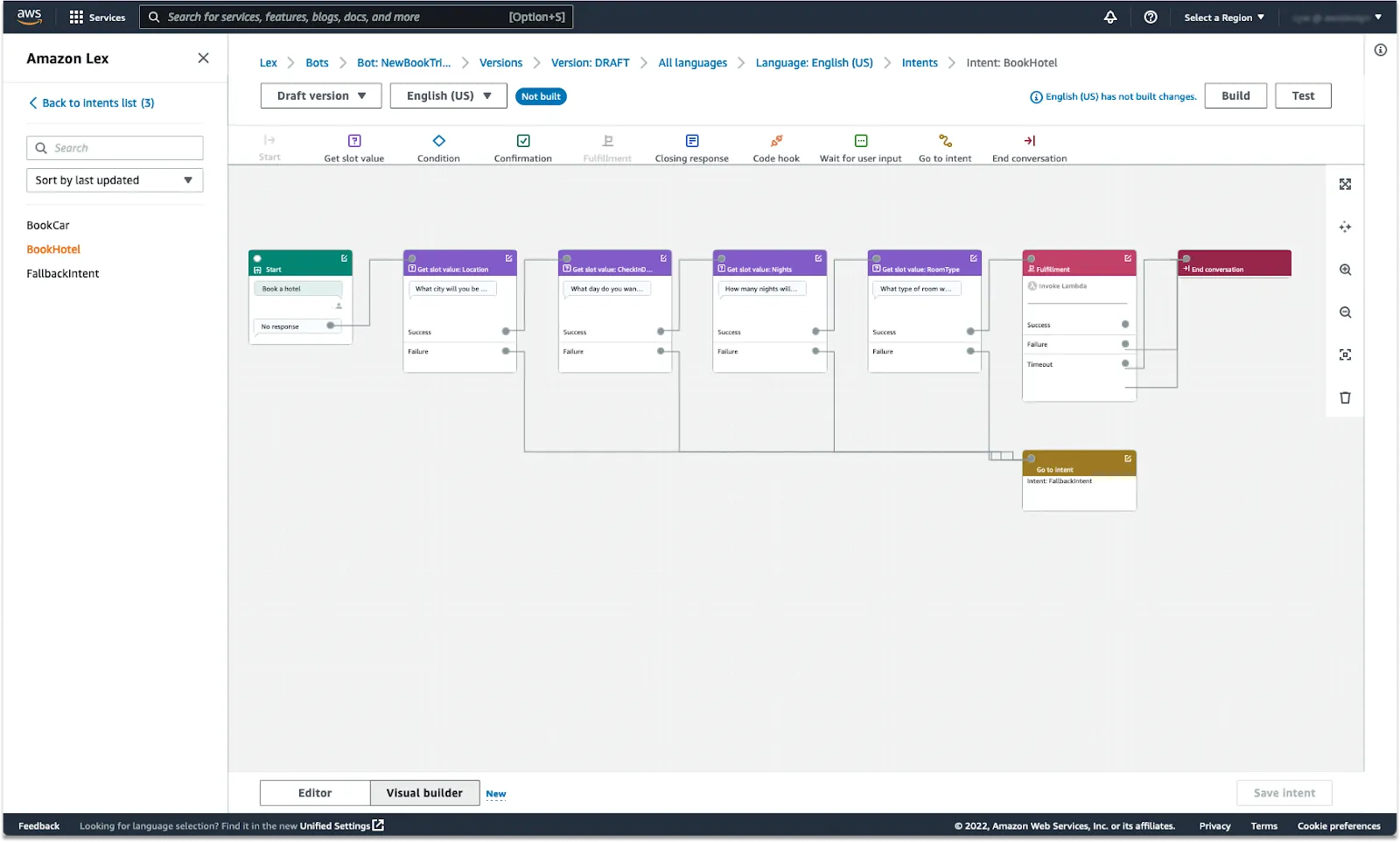
Amazon Lex is the engine behind Alexa’s voice capabilities, now offered as a service for building your own chatbots and voice assistants.
It’s great for automating repetitive tasks like customer support FAQs, appointment bookings, or IT helpdesk requests using both voice and text. If you’re already an AWS customer, Lex fits neatly into your stack.
Best for:
Businesses that use AWS and need chatbots to automate repetitive workflows (customer support, scheduling, etc.) with minimal hassle.
Pros:
Cons:
Pricing:
Comes with a free tier (up to 10,000 text requests or 5,000 voice requests per month). Beyond that, it’s usage-based – roughly $0.004 per voice request and $0.00075 per text request (so you pay only for what you use).
4. Google Dialogflow
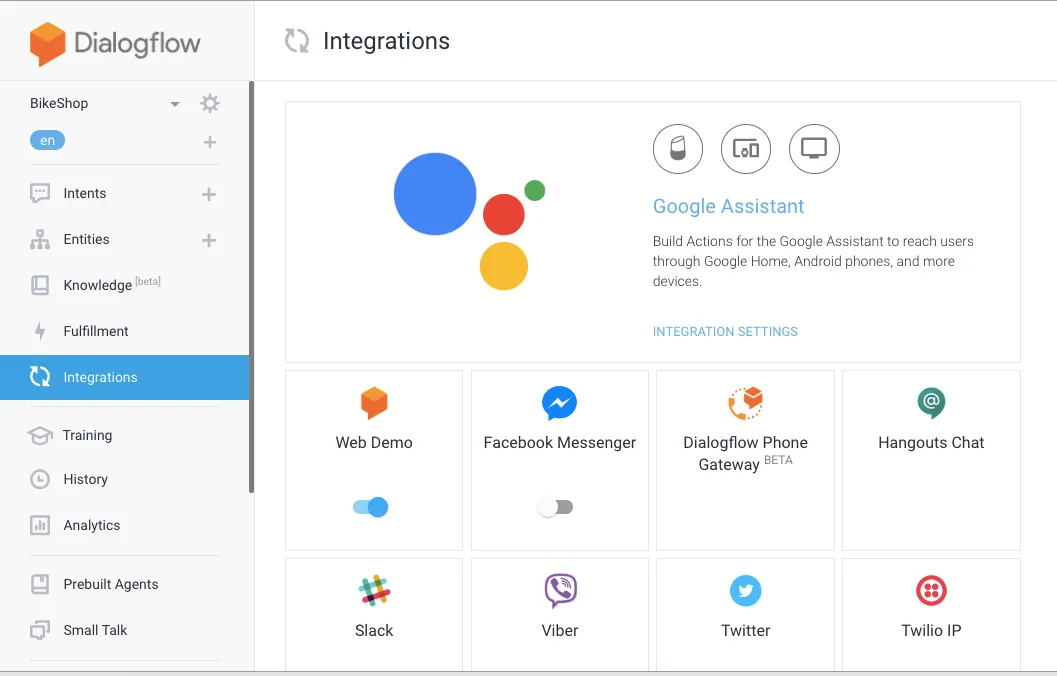
Google Dialogflow is another popular platform for creating AI chatbots and voice assistants. You can design conversation flows with a visual builder and enhance them with Google’s machine learning.
The advanced version, Dialogflow CX, offers a powerful drag-and-drop interface that makes it easier to build complex, multi-turn conversations in multiple languages.
In short, Dialogflow gives you significant control over your bot’s behavior while still leveraging Google’s AI to handle natural language understanding.
Best For:
Businesses seeking a user-friendly yet powerful platform to create multi-language chatbots, especially if they already use Google Cloud services.
Pros:
Cons:
Pricing:
Dialogflow offers a free trial edition. Paid usage is on a pay-per-request model – roughly $0.012 per text request and $0.002 per second of audio processing for voice interactions (pricing varies slightly by edition and region).
5. Avaamo

Avaamo is an enterprise-grade conversational AI platform built to deliver personalized, seamless customer experiences at scale. It comes with a state-of-the-art natural language understanding engine and strong sentiment analysis.
Avaamo really shines in industry-specific solutions – it offers pre-trained AI models and workflows tailored for domains like banking, insurance, retail, and healthcare.
Best for:
Large banks, insurers, hospitals, and other enterprises that need multilingual, industry-specific AI virtual assistants (with strict security and compliance).
Pros:
Cons:
Pricing:
Not publicly listed. Avaamo typically works on a custom pricing model – you’ll need to contact them for a quote based on your requirements.
6. Kore.ai
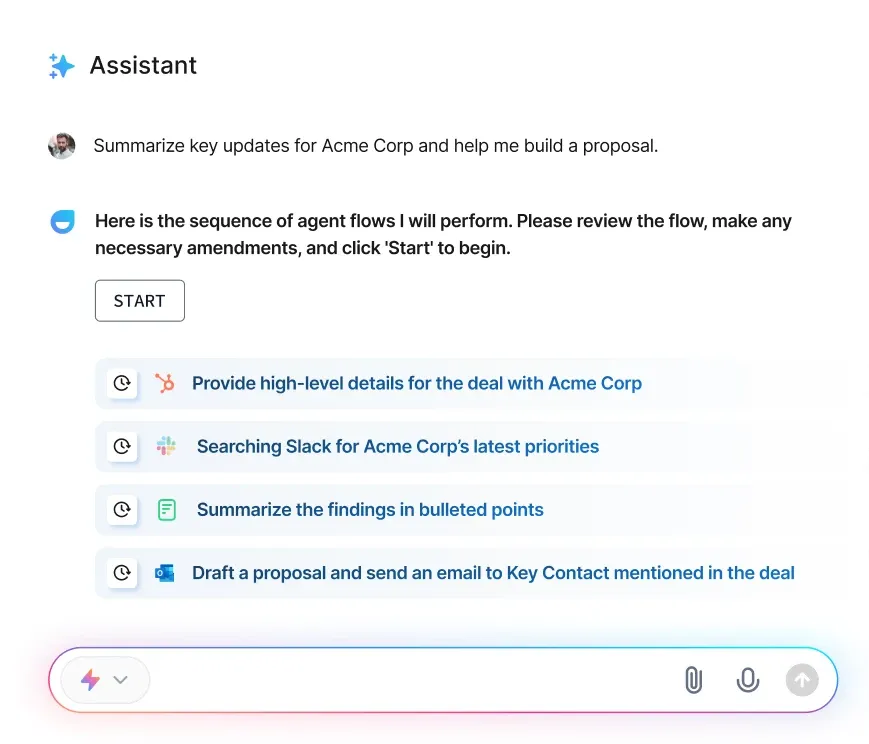
Kore.ai is a platform that helps enterprises build chatbots and AI assistants without writing a single line of code. It provides a drag-and-drop conversation designer, a large library of pre-built bot templates, and plenty of integrations to automate tasks across systems.
In a nutshell, Kore.ai enables your team (even non-developers) to create chatbots that help customers find answers or perform tasks faster, with AI working behind the scenes.
Best for:
Enterprise teams that want their “citizen developers” (non-technical staff) to create chatbots for customer service or internal workflows, using a guided no-code environment.
Pros:
Cons:
Pricing:
Kore.ai’s paid plans start around $50/month, which typically covers about 1,000 bot sessions. (Larger deployments and enterprise features will increase the cost.)
7. Microsoft Bot Framework
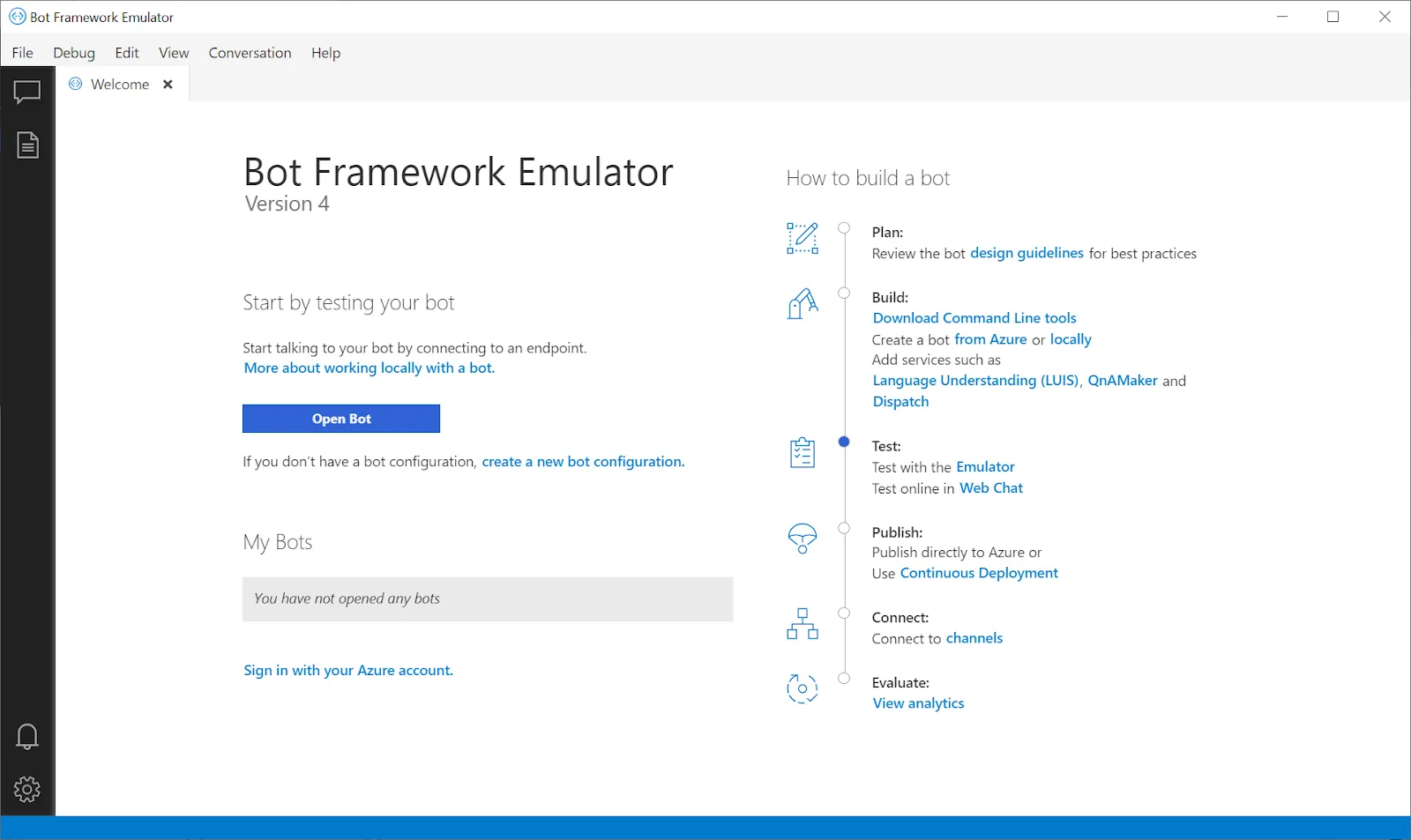
Microsoft’s Bot Framework is a developer-centric platform for building custom chatbots and virtual assistants, particularly suited for those already using Azure services. It’s essentially an SDK and set of tools that let programmers create bots with full control over the code and data. By leveraging Azure Cognitive Services (like speech recognition and language understanding), you can infuse natural language capabilities into your bots.
This platform is all about flexibility and extensibility – you build exactly what you need, with the trade-off of requiring coding skills.
Best for:
Developer-first companies who want a highly customizable, code-friendly bot builder platform with enterprise-grade security and scalability.
Pros:
Cons:
Pricing:
The core Bot Framework SDK is free to use. If you deploy on Azure, there may be costs for the Azure Bot Service and any Cognitive Services you use. As a guideline, Azure’s Bot Service charges around $0.50 per 1,000 messages (after a generous free quota of messages each month).
8. Yellow.ai
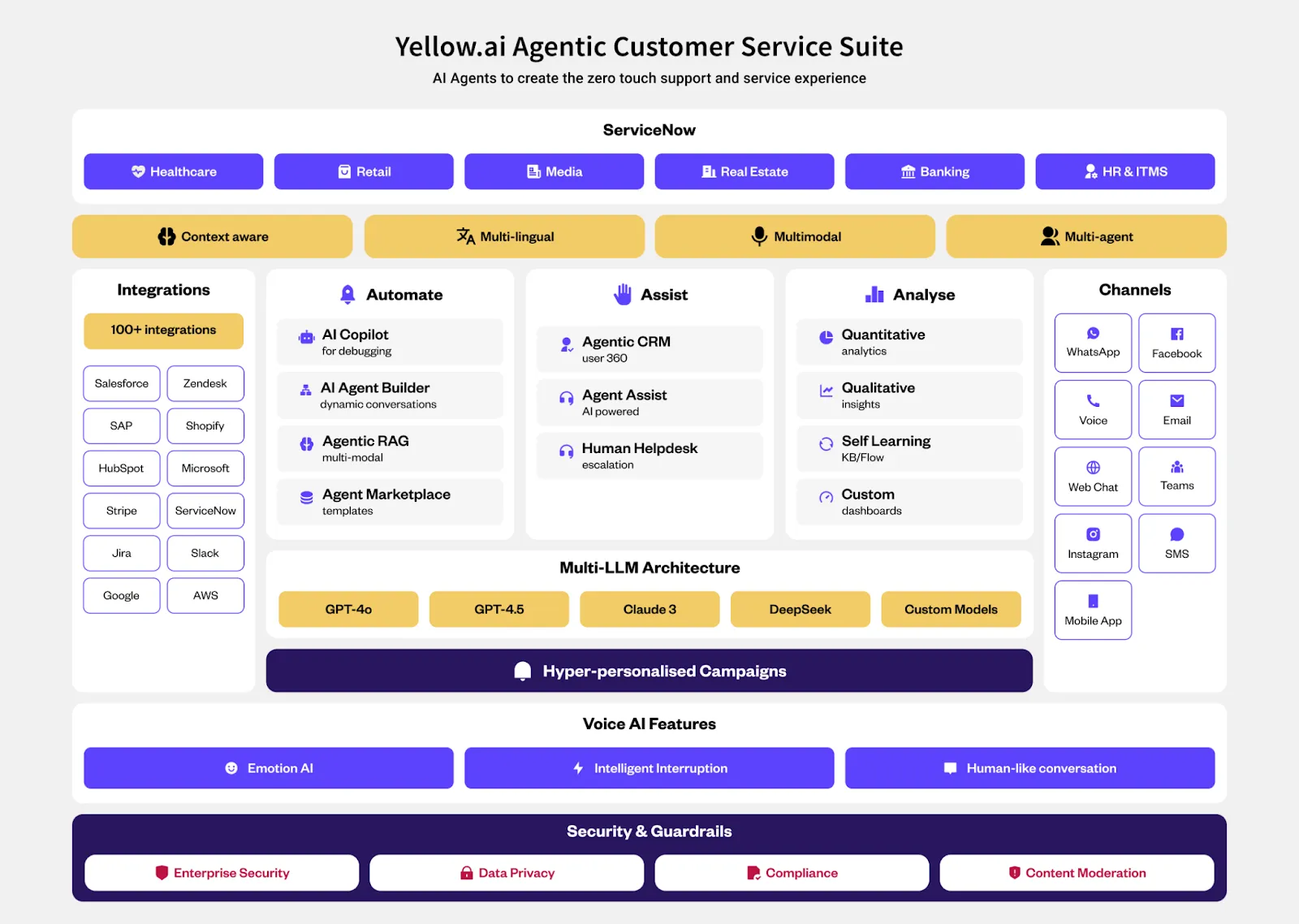
Yellow.ai is an “agentic” AI platform that enables 24/7 customer service across both voice and chat channels. Its AI agents use Yellow.ai’s proprietary LLMs to provide fast, accurate, and personalized responses. With support for over 35 channels (from WhatsApp and Messenger to Slack and voice calls) and 130+ languages, Yellow.ai helps businesses reach customers on their preferred platform in their own language.
Essentially, Yellow.ai offers an out-of-the-box omnichannel chatbot solution with a lot of flexibility for customization as you grow.
Best for:
Organizations that want a ready-to-use, omnichannel AI customer service solution with broad language coverage – especially useful if you need to manage support on many platforms simultaneously.
Pros:
Cons:
Pricing:
Yellow.ai offers a free plan with basic features to get started. Details on paid plans are not publicly disclosed – you’d need to contact Yellow.ai for pricing tailored to your usage and requirements.
9. Cognigy.AI

Cognigy.AI is a platform for building AI agents that handle both chat and voice conversations, with an emphasis on delivering fast, personalized service at scale. Its generative AI capabilities help the bots sound natural and carry out more complex, empathetic dialogues.
Cognigy also excels at integrating with your existing backend systems and even assisting live agents in real time (for instance, by suggesting answers or translating on the fly).
Best for:
Enterprise teams that require high-volume, multi-channel customer support automation with advanced AI capabilities – especially if they need the bot deeply integrated into internal systems and workflows.
Pros:
Cons:
Pricing:
Enterprise teams that require high-volume, multi-channel customer support automation with advanced AI capabilities – especially if they need the bot deeply integrated into internal systems and workflows.
10. Aisera
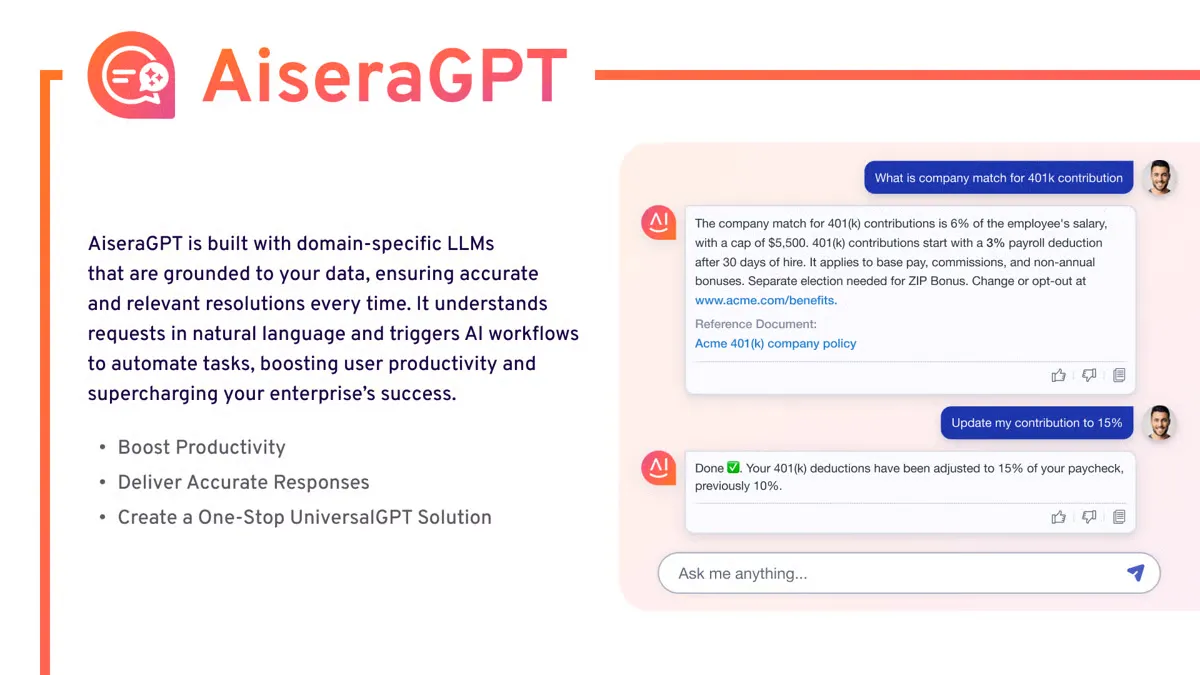
Aisera is a generative AI platform geared towards automating support across multiple departments – from IT helpdesks and customer service to sales inquiries. It enables businesses to deploy AI copilots (virtual agents) for each department through a central “AI Copilot” hub.
These AI agents use large language models to handle requests in real time without relying solely on pre-scripted answers. The result is faster customer interactions that still feel natural and context-aware.
In practice, Aisera’s bots can resolve common questions or issues autonomously, escalating to humans only when needed, which helps teams work more efficiently.
Best for:
Enterprises that want to streamline and scale their customer and employee support across various departments (IT, HR, customer support, sales) using AI, while maintaining a high-quality experience.
Pros:
Cons:
Pricing:
Not publicly listed. Aisera typically provides custom pricing based on the scope (number of users, modules, integrations, etc.), so you’d need to reach out to their sales team for a quote.
Beyond Chatbots: AI Tools That Improve Sales Conversations
The platforms above are often thought of as chatbot builders or virtual agents for handling customer queries. But beyond these traditional chatbot use cases, there’s a growing class of AI tools focused on improving the conversations that salespeople have with customers (rather than replacing those conversations). These solutions use AI to help sales teams train, coach, and communicate more effectively, turning conversational AI into a sales enablement powerhouse.
For instance, MeetRecord (as discussed) takes a conversation intelligence and sales coaching approach: it analyzes real sales calls and meetings to surface key insights like buyer intent signals or effective talk tracks, and even provides real-time coaching cues to reps during live calls. On the other hand, its AI Sales Roleplay module lets teams create custom practice bots based on actual pipeline scenarios or even modeled after specific contacts. This means reps can rehearse objections, refine messaging, and perfect delivery in a safe, simulated environment that mirrors the real conversations they’re about to have.
By blending live deal intelligence with tailored, scenario-based practice, MeetRecord ensures that reps aren’t just reacting to conversations but also that they’re proactively preparing for them, making every customer interaction more effective. Essentially, it transforms raw conversations into a rich coaching resource for revenue teams.
Similarly, Allego, a sales enablement platform, has introduced an AI-powered Live Dialog Simulator that delivers video-based role-play sessions. Reps can engage in what feels like a real buyer meeting with the AI, anytime and anywhere, without needing a manager or peer to role-play. By integrating these simulations with real conversation intelligence data, tools like Allego provide a comprehensive coaching loop – practice with AI, then apply learnings on real calls, which are also analyzed by AI.
In short, conversational AI in sales enablement goes beyond automating chat responses. It’s about using AI to sharpen your team’s conversational skills and strategy. Whether through post-call analysis (as with MeetRecord and other conversation intelligence tools) or via interactive role-play training (as with MeetRecord, Second Nature, Allego, and others), these AI solutions ensure that every sales conversation – live or practice – is continually improving. For sales leaders, that means more consistent messaging, better handling of objections, and ultimately more deals won.
Benefits of Conversational AI Platforms
Conversational AI platforms help you handle more customer conversations, improve response quality, and identify hidden opportunities without adding headcount.
Here are five key benefits of using conversational AI platforms to grow in 2025.
1. Better Customer Engagement
Conversational AI platforms go beyond rule-based responses by understanding user intent and proactively engaging customers.
These platforms can initiate conversations, guide users with relevant resources, provide additional product information, and suggest the next steps without needing a human to oversee the process.
2. Personalization
Conversational AI platforms use historical data and context to offer personalized customer interactions and remove the need for customers to repeat themselves.
They offer personalized recommendations which help businesses cross-sell and upsell products to customers. It’s a win-win; customers get a delightful experience while business can improve their revenue potential.
3. Consistent Customer Experience
Conversational AI brings uniformity in communication across all customer channels. On top of handling repetitive tasks and queries, the automated responses build brand consistency in terms of response time and brand voice.
Businesses can program AI bots to handle a variety of use cases to create consistent customer journeys. This approach improves the overall support experience and also builds brand credibility.
4. Scalability
Conversational AI platforms help businesses to scale their customer-facing operations without adding headcounts.
For instance, you can notch up your customer communication across multiple touchpoints when expanding to new markets or handle temporary surges in demand, such as during holiday seasons.
You can scale it down during normal business months to save costs and avoid overwhelming your bandwidth. This control over scalability means you can meet your business’ growing demand without significant overhead.
5. Cost Efficiency
Maintaining customer queries around the clock is expensive, with or without the right tools.
But conversational AI platforms can shave off that cost significantly. That’s because you can use them to deploy intelligent chatbots that operate 24/7 to engage with customers.
Key Features to Look For in Conversational AI Platform
A good conversational AI platform should be easy to adopt, work well with your existing tools, and help you get value fast.
Before you choose one, focus on the following four things that really matter:
1. AI Capabilities
Look under the hood at how sophisticated the platform’s AI really is. Many so-called “AI” tools are just glorified decision trees with a bit of GPT sprinkled on top. Don’t settle for a rigid, scripted bot that only has AI at the surface level.
Instead, seek out a platform that uses advanced NLP and machine learning to handle complex, unscripted questions and conversations. The AI should learn and evolve from each interaction. This adaptability is key to long-term effectiveness, ensuring the assistant stays relevant as your business grows and customer needs change.
2. Easy Setup and User-Friendly Interface
Your success with a new tech depends on how easy it is to use, set up, and adopt.
Look for platforms that don’t require coding knowledge to start with. A strong AI product is easy to deploy, simple to navigate, and lets end users prompt like a fifth-grader.
Choose a platform with a user-friendly interface that simplifies training and onboarding. You can’t go wrong with a tool that cuts down onboarding time with intuitive dashboards and guided workflows.
3. Integration with Existing Systems
If your conversational AI platform doesn’t play nicely with your CRM, helpdesk, or analytics suite, it can quickly become a siloed tool that nobody wants to use. Seamless integration is crucial. Ensure the platform has pre-built connectors or APIs for the major software systems your business relies on.
The fewer manual workarounds or data exports you need, the better. Wide-ranging native integrations (or at least flexible APIs) will let the AI pull in relevant data (like order history from your CRM) and push transcripts or insights back to your databases. This not only saves time but also makes the AI’s responses more context-aware.
4. Scalability and Flexibility
Buying a conversational AI platform is a forward-looking investment. You’re not just solving today’s problems – you’re preparing for future growth. So think about whether the platform can scale with you.
- Can it handle a surge in usage or an expansion to new languages and channels?
- Can you customize workflows as your needs evolve?
A good conversational AI tool should be capable of growing without breaking – whether that means handling 10x more traffic, supporting new use cases, or allowing deeper custom integrations down the line. If the platform is too rigid or maxes out on capacity, you might outgrow it faster than you think.
How Does Conversational AI Drive Revenue?
At MeetRecord, we regularly interact with a fair share of revenue leaders who are obsessed with one question: how do we grow revenue without adding more headcount, more systems, or more complexity?
That’s where conversational AI enters the picture as a new model for a “revenue engine.” Let’s break down exactly how conversational AI contributes to this goal.
1. Hyper-Personalization for Increased Conversions
Every buyer wants to feel like the experience was made just for them. And they can tell when it isn’t.
Conversational AI helps close that gap by pulling data from browsing history, past purchases, and behavioral data to guide the interaction.
Imagine a prospect visiting your website. Instead of offering a generic pricing page, a well-trained AI assistant starts a conversation:
"Are you looking to scale your team, automate workflows, or improve client delivery?"
Based on their answers, the AI can recommend the right product tier, share a relevant case study from their industry, or offer to book the calendar with the right rep.
That’s not just automation; it’s an efficient path to generate revenue.
In fact, companies that personalize experiences grow 40% faster than those that don’t, according to McKinsey’s research on growth through personalization.
Every personalized interaction builds trust, and conversational AI is capable of making it happen every minute of every day.
2. Smarter Targeting to Reach the Right Audience
One of the biggest mistakes I see companies make is wasting money on reach, but not relevance. Think of running paid ads on the wrong platform without knowing who’s actually ready to buy.
You might have the best product in the world, but if you show it to the wrong people (or at the wrong time), you’re fishing in the wrong pond.
What conversational AI makes possible is something sales and marketing teams have been chasing for years: precision at scale.
AI does this by analyzing your customers’ behavioral signals such as search terms, past site visits, or content consumption patterns. It then matches those data points with the most relevant messaging, product tier, or next step.
And it works. 72% of B2B buyers expect vendors to personalize engagement to their needs, and those who do see dramatically higher conversion rates.
Smarter targeting can elevate your revenue if you can align your offer, audience, and timing in harmony.
3. Proactive Messaging for Improved Engagement
Most businesses still wait for buyers to make the first move, through chat, forms, or emails.
But in today’s market, it’s a luxury you can’t afford.
Customers are already overwhelmed, distracted, and moving from one thing to another in quick succession. If you’re not top of mind, someone else will be.
With conversational AI, you don’t sit back waiting for customers to come. It initiatives conversations where customers are in their journey. For instance, it analyzes what they’ve clicked, searched, or ignored and acts on that data in real-time.
It can send a tailored message, offer support, nudge them toward the next step, or surface a promotion before the customer even asks.
And the results speak for themselves. Businesses that use proactive messaging on their website see up to a 10x increase in engagement.
4. Faster Lead Qualification
Sales teams lose deals every day either because the product is wrong, the follow-up is late, or because of an ICP mismatch.
The window to qualify a lead is short. If you ask the wrong questions, wait too long to respond, or route their queries to the wrong person, you’ll lose an opportunity.
Conversational AI jumps in as soon as a buyer engages on a channel, asks smart questions, and scores the lead instantly. It can also segment them and map them to the right sales rep (or offer).
In sales, speed is a competitive advantage. With AI handling the first interaction, sales reps can skip the back-and-forth and focus on closing. Conversational AI shortens the deal cycles and builds your pipeline with the right leads.
5. Up-Selling and Cross-Selling to Increase Order Value
Retention and expansion revenue are two of the most overlooked ways to grow sustainably without chasing new leads.
Conversational AI bridges that gap by identifying the right upsells and cross-sell opportunities and pitching the buyers at the right time.
If a buyer is evaluating a project management app, for instance, the AI can recommend add-ons like additional user seats, extra storage, or team chat options based on their org size and goals.
6. Improving the Customer Buying Experience
The online buyer experience today is heavily self-service. But the biggest friction in most customer journeys isn’t price or product, it’s the effort customers have to put in to dig up even simple information.
When customers struggle to find answers, compare options, or get timely support, they bounce.
AI-powered assistants can guide customers through every step, from answering a pricing question to recommending the right plan based on their needs.
It’s like having a knowledgeable rep on standby 24/7. This matters more than most businesses realize.
According to PwC, 73% of consumers say customer experience plays a key role in their buying decisions, and bad experiences are enough to drive them away.
7. Reducing Operational Costs for Increased Profitability
Every leadership team wants the same thing: to achieve more without spending more.
Conversational AI creates real financial impact by helping lean revenue teams work faster and double their productivity.
Think about the times your team answered the same basic questions: “Do you offer a free trial?” “Do you integrate with Salesforce?” or “What’s your pricing?”
Your best teams shouldn’t be spending time on these questions. Conversational AI takes that manual workload off their plates.
How to Choose the Right Conversational AI Platform?
Buying a conversational AI platform is not like buying a chatbot builder in 2018.
You’re investing in a system that will face your customers daily, represent your brand, and influence revenue outcomes. It’s a high-stakes purchase.
1. Start With Clear Business Goals
The first step is clarity. What problem are you solving? Are you looking to reduce support tickets, accelerate sales conversations, onboard new users, or engage global audiences?
The best platform for a support-heavy org may look very different from one focused on revenue growth or customer expansion.
2. Understand No-Code vs. Low-Code Tradeoffs
From there, look at how the platform is built. A no-code tool might sound appealing, especially for teams without engineering bandwidth.
But it can be limiting when you need more control or customization. If your use case is complex, you’ll want low-code flexibility so your team can fine-tune workflows or integrate deeply with your stack.
3. Prioritize Integrations
Don’t overlook integrations. Your AI platform shouldn’t live in a silo. It should integrate with your CRM, ticketing system, analytics platform, and messaging channels like Slack, Teams, and WhatsApp.
The goal should be to make the AI feel like a natural extension of your business, not a separate channel with its own rules.
4. Evaluate the AI Model
The model is the brain that powers an AI bot. Most platforms claim to use GPT, but that’s only part of the story.
What really matters is what that model was trained on. If the AI hasn’t seen your industry’s jargon, workflows, or buyer behavior, it’ll fumble,even with the best UI.
Look for platforms that offer industry-specific training data or pre-built templates tuned to your vertical. This saves you months of tweaking later.
5. Don’t Compromise on Data Security
Finally, don’t gloss over data privacy. You’re trusting this system with sensitive information: customer conversations, internal workflows, and buying intent.
Make sure the vendor complies with GDPR, HIPAA, and CCPA, and ask about past incidents. If they’ve had a breach, you deserve to know.
Conversational AI Can Be Your Force Multiplier
From qualifying leads to highlighting deal risks buried in sales conversations, conversational AI has moved far beyond the era of clunky scripted replies. In 2025, it’s not just about chatbots answering basic questions – it’s about intelligent systems that act as a force multiplier for your revenue teams.
Conversational AI is becoming a core revenue lever, but it will only pay off if you choose the right tool for your needs. If your focus is driving revenue – from the first touch with a prospect all the way through to renewal and expansion – a platform like MeetRecord is built for exactly that. Unlike most AI bot platforms, with MeetRecord you don’t have to construct anything from scratch or maintain complex dialogue trees. It’s already embedded in your sales workflow, automatically mapping patterns across conversations, drawing out insights, and spotting deal risks that you might have missed. It even brings in the human element by coaching your reps in real time and enabling realistic practice sessions to hone their skills.
In the end, the best conversational AI platform is one that amplifies what your team can do. It should handle the heavy lifting of routine conversations and analyses, while empowering your people to focus on high-value activities. Get it right, and you’ll have an AI assistant that feels less like software and more like a scalable extension of your team.
Want to see what that looks like in action? Book a demo and see what AI can do for you.
Frequently Asked Questions
Conversational AI is a type of artificial intelligence that can understand, process, and respond to human language in a natural, human-like way.
A chatbot follows pre-set rules and scripts, while conversational AI uses machine learning and NLP to understand context and hold smarter, more dynamic conversations.
A conventional AI example is a rule-based system like a spam filter, which follows fixed logic to make decisions without learning from new data.
The best conversational AI depends on your use case, but leading platforms in 2025 include tools that offer advanced NLP, real-time coaching, and CRM integrations.
Conversational AI helps sales teams qualify leads, handle objections, and improve rep performance through real-time feedback and intelligent coaching.


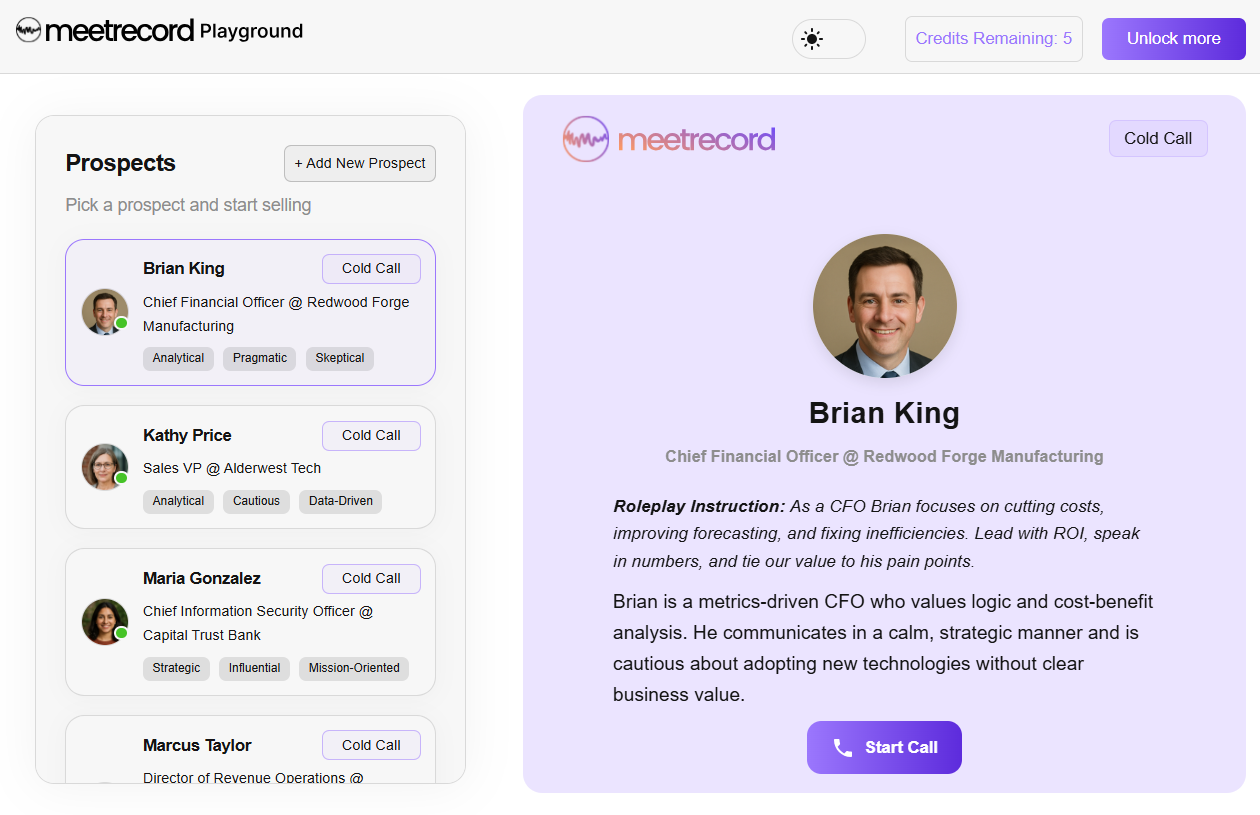
.svg)

.webp)

